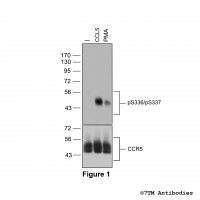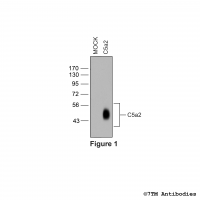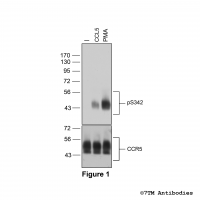No results were found for the filter!
NEW
 pS336/pS337-CCR5 (phospho-Chemokine Receptor 5...
pS336/pS337-CCR5 (phospho-Chemokine Receptor 5... Serine336/Serine337 (S336/S337) is a major phosphorylation site of the CCR5 receptor. The pS336/pS337-CCR5 antibody detects phosphorylation in response to high- and low-efficacy agonists and after PKC activation. S336/S337...
$ 375.00 *
NEW
 pS387/pS388-PAR2 (phospho-Proteinase-Activated...
pS387/pS388-PAR2 (phospho-Proteinase-Activated... Serine387/Serine388 (S383/S384) is major phosphorylation site of the Proteinase-Activated Receptor 2 (PAR2). The pS387/pS388-PAR2 antibody detects phosphorylation in response to agonists. S387/S388 phosphorylation is likely to be...
$ 375.00 *
NEW
 pS364-β2 (phospho-β2-Adrenoceptor Antibody)
pS364-β2 (phospho-β2-Adrenoceptor Antibody) Serine364 (S364) is a major phosphorylation site of the β2 adrenoceptor. The pS364-β2 antibody detects phosphorylation in response to high- and low-efficacy agonists but not after PKC activation. S364 phosphorylation is primarily...
$ 375.00 *
NEW
 pT382/pT386-D5 (phospho-Dopamine Receptor 5...
pT382/pT386-D5 (phospho-Dopamine Receptor 5... Threonine382/Threonine386 (T382/T386) is a major phosphorylation site of the D5 receptor. The pT382/pT386-D5 antibody detects phosphorylation in response to high- and low-efficacy agonists but not after PKC activation. T382/T386...
$ 375.00 *
Citations
NEW
 C5a2 (non-phospho), Complement C5a Receptor 2...
C5a2 (non-phospho), Complement C5a Receptor 2... The non-phospho-C5a2 receptor antibody is directed against the distal part of the carboxyl-terminal tail of human C5a2. It can be used to detect total C5a2 receptors in Western blots independent of phosphorylation. The non-phospho-C5a2...
$ 375.00 *
NEW
 ACKR2 (non-phospho), Atypical Chemokine...
ACKR2 (non-phospho), Atypical Chemokine... The non-phospho-ACKR2 receptor antibody is directed against the distal part of the carboxyl-terminal tail of human ACKR2. It can be used to detect total ACKR2 receptors in Western blots independent of phosphorylation. The...
$ 375.00 *
NEW
 pT355-CCR10 (phospho-Chemokine Receptor 10...
pT355-CCR10 (phospho-Chemokine Receptor 10... Threonine355 (T355) is a major phosphorylation site of the CCR10 receptor. The pT355-CCR10 antibody detects phosphorylation in response to high- and low-efficacy agonists and after PKC activation. T355 phosphorylation is a key regulator...
$ 375.00 *
SAMPLE PACK
 M2 Sample Pack (phospho- and non-phospho-M2...
M2 Sample Pack (phospho- and non-phospho-M2... M2 Sample Pack consisting of all six available phospho- and one non-phospho-M2 Receptor Antibodies 7 x 20 µL trial size each. Specifically, this sample pack contains the following antibodies pT271-M2 (7TM0014A), pS282/pS283-M2...
$ 300.00 *
SAMPLE PACK
 C5a1 Sample Pack (phospho- and non-phospho-C5a1...
C5a1 Sample Pack (phospho- and non-phospho-C5a1... C51 Sample Pack consisting of all five available phospho- and two non-phospho-C5a1 Receptor Antibodies 7 x 20 µL trial size each. Specifically, this sample pack contains the following antibodies pT324/pS327-C5a1 (7TM0032A),...
$ 400.00 *
SAMPLE PACK
 MOP Sample Pack (phospho- and...
MOP Sample Pack (phospho- and... MOP Sample Pack consisting of all four available phospho- and one non-phospho-µ-Opioid Receptor Antibodies 5 x 20 µL trial size each. Specifically, this sample pack contains the following antibodies pT370-MOP (7TM0319B), pS375-MOP...
$ 300.00 *
SAMPLE PACK
 β2-Adrenoceptor Sample Pack (phospho- and...
β2-Adrenoceptor Sample Pack (phospho- and... β2-Adrenoceptor Antibody Sample Pack consisting of three phospho- and one non-phospho-β2-Adrenoceptor Antibodies 4 x 20 µL trial size each. Specifically, this sample pack contains the following antibodies pS355/pS356-β2 (7TM0029A),...
$ 300.00 *
NEW
 pS385/pS387-NPFF1 (phospho-Neuropeptide FF...
pS385/pS387-NPFF1 (phospho-Neuropeptide FF... Serine385/Serine387 (S385/S387) is major phosphorylation site of the Neuropeptide FF Receptor 1 (NPFF1). The pS385/pS387-NPFF1 antibody detects phosphorylation in response to agonists. S385/S387 phosphorylation is likely to be involved...
$ 375.00 *
Citations
NEW
 pS355/pS356-β2 (phospho-β2-Adrenoceptor Antibody)
pS355/pS356-β2 (phospho-β2-Adrenoceptor Antibody) Serine355/Serine356 (S355/S356) is a major phosphorylation site of the β2 adrenoceptor. The pS355/pS356-β2 antibody detects phosphorylation in response to high- and low-efficacy agonists but not after PKC activation. S355/S356...
$ 375.00 *
NEW
 pS257/pT262-D3 (phospho-Dopamine Receptor 3...
pS257/pT262-D3 (phospho-Dopamine Receptor 3... Serine257/Threonine262 (S257/T262) is a major phosphorylation site of the D3 dopamine receptor. The pS257/pT262-D3 antibody detects phosphorylation in response to high- and low-efficacy agonists but not after PKC activation. S262/T262...
$ 375.00 *
NEW
 pS342-CCR5 (phospho-Chemokine Receptor 5 Antibody)
pS342-CCR5 (phospho-Chemokine Receptor 5 Antibody) Serine342 (S342) is a major phosphorylation site of the CCR5 receptor. The pS342-CCR5 antibody detects phosphorylation in response to high- and low-efficacy agonists and after PKC activation. S342 phosphorylation is a key regulator of...
$ 375.00 *
NEW
 pT340-CCR5 (phospho-Chemokine Receptor 5 Antibody)
pT340-CCR5 (phospho-Chemokine Receptor 5 Antibody) Threonine340 (T340) is a major phosphorylation site of the CCR5 receptor. The pT340-CCR5 antibody detects phosphorylation in response to high- and low-efficacy agonists and after PKC activation. T340 phosphorylation is a key regulator of...
$ 375.00 *
Recently viewed


